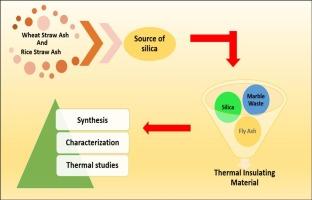大理岩废稻麦秸灰基复合材料隔热性能的对比研究
IF 4.6
3区 材料科学
Q2 MATERIALS SCIENCE, MULTIDISCIPLINARY
引用次数: 0
摘要
越来越多的工业和农业废物,如大理石废物、粉煤灰、稻草灰(RSA)和小麦秸秆灰(WSA),带来了环境挑战,但也为可持续材料开发提供了机会。研究了以RSA和WSA为硅源,与大理石废料和粉煤灰复合合成隔热地聚合物复合材料。采用x射线衍射(XRD)、傅里叶变换红外光谱(FTIR)、场发射扫描电镜(FESEM)、BET表面积分析以及导热系数、扩散系数和比热测量对材料进行了表征。XRD分析证实两种材料均存在正硅酸钙相及相关硅酸盐相,RSA结晶度略高。FTIR分析证实了拉伸和弯曲振动和类似的硅酸盐结构,但RSA基材料具有更多的非晶相。FESEM成像的微观结构分析和存在的孔隙或气隙的材料。BET分析证实,RSA基材料具有更高的表面积和孔隙宽度,有助于提高其隔热性能。wsa基材料的导热系数为0.2454 W/mK,而rsa基材料的导热系数略低,为0.2312 W/mK,保温性能较好。这些发现表明,这两种材料都可以有效地用于开发环保隔热材料,选择取决于机械强度和绝缘性能的特定应用要求。本文章由计算机程序翻译,如有差异,请以英文原文为准。

Comparative study on the thermal insulating potential of rice and wheat straw ash based composite using marble waste
The increasing generation of industrial and agricultural waste—such as marble waste, fly ash, rice straw ash (RSA), and wheat straw ash (WSA)—poses environmental challenges but also offers opportunities for sustainable material development. This study investigates the use of RSA and WSA as silica sources for synthesizing thermally insulating geopolymer composites in combination with marble waste and fly ash. The materials were characterized using X-ray diffraction (XRD), Fourier-transform infrared spectroscopy (FTIR), Field emission scanning electron microscopy (FESEM), and BET surface area analysis, along with measurements of thermal conductivity, diffusivity, and specific heat. XRD analysis confirmed the presence of calcium orthosilicate phase and related silicate phases in both materials, with RSA showing slightly higher crystallinity. FTIR analysis confirms the stretching and bending vibrations and similar silicate structures, but, RSA based material had a higher number of amorphous phases. FESEM imaging the microstructure analysis and presence of pores or air gaps in the material. BET analysis confirmed higher surface area and pore width in the RSA based material, contributing to its improved thermal insulation. The thermal conductivity of the WSA-based material was reported as 0.2454 W/mK, whereas the RSA-based material had a slightly lower value of 0.2312 W/mK, indicating better insulation. These findings demonstrate that both materials can be effectively utilized in the development of eco-friendly thermal insulating materials, with the choice depending on application-specific requirements for mechanical strength versus insulation performance.
求助全文
通过发布文献求助,成功后即可免费获取论文全文。
去求助
来源期刊

Materials Science and Engineering: B
工程技术-材料科学:综合
CiteScore
5.60
自引率
2.80%
发文量
481
审稿时长
3.5 months
期刊介绍:
The journal provides an international medium for the publication of theoretical and experimental studies and reviews related to the electronic, electrochemical, ionic, magnetic, optical, and biosensing properties of solid state materials in bulk, thin film and particulate forms. Papers dealing with synthesis, processing, characterization, structure, physical properties and computational aspects of nano-crystalline, crystalline, amorphous and glassy forms of ceramics, semiconductors, layered insertion compounds, low-dimensional compounds and systems, fast-ion conductors, polymers and dielectrics are viewed as suitable for publication. Articles focused on nano-structured aspects of these advanced solid-state materials will also be considered suitable.
 求助内容:
求助内容: 应助结果提醒方式:
应助结果提醒方式:


